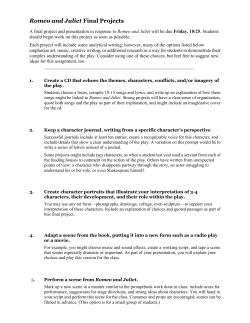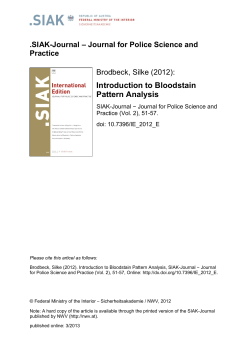
Blood Spatter Interpretation at Crime Scenes
Blood Spatter Interpretation at Crime and Accident Scenes Louis L. Akin 3/01/04 Blood Spatter Interpretation at Crime Scenes for First Responders, Homicide Detectives, Crime Scene Technicians. Excerpted from: Blood Spatter Interpretation at Crime and Accident Scenes: A Step by Step Guide for Medicolegal Investigators.© By Louis L. Akin, LPI Through a variety of schools, classes, and seminars homicide detectives and crime scene technicians are garnering a level of expertise that has not previously existed in law enforcement. New technologies, sciences, and applied sciences are available for detectives and criminalists to use in solving crimes and apprehending offenders. Criminalists need to be more knowledgeable in the scientific aspects of technology and techniques; however, law enforcement personnel do not have to become scientist to take advantage of the technology or to apply the scientific methods that are available. Blood spatter analysis is a clear example of an applied science that a homicide detective or first responder can learn without having to become an expert in the field. Blood spatter interpretation may be compared to tracking. It may take considerable training to reach the level of a tracker who can say that a footprint was made two days before by a running, pigeon towed, 180 male, who has bunions on both feet. It does not require that level of training or expertise to be able to look at a footprint and determine which way the person was going. Just pick out the heel and toe. Although, an expert may be able to see things in the blood that the crime scene detective doesn’t, a detective can learn to determine where a victim was positioned by looking at the blood spatter at a scene the same way he could tell which way a footprint is going. The first responder can learn to see patterns at a scene that indicate that the incident may not have happened as witnesses have described it. A basic understanding of blood spatter analysis will also allow the first responder and investigator to assist in correctly collecting and preserving blood stain data at the scene. Fortunately, the principles and procedures to learn are not complicated and, while it is easier to use software to make the calculations, the basic principles can be learned from a source as brief as this article and applied using a hand held calculator. Some critical determinations, such as establishing the point of convergence that shows where the victim was standing can be done without use of a calculator at all. This basic understanding is important, because the interpretation of blood spatter patterns and other evidence at crime scenes may reveal critically important information such as: • The positions of the victim, assailant, and objects at the scene. • The type of weapon that was used to cause the spatter. • The number of blows, shots, stabs, etc. that occurred. • The movement and direction of victim and assailant, after bloodshed began. • It may support or contradict statements given by witnessesi. The investigator may use blood spatter interpretation to determine: 1 Blood Spatter Interpretation at Crime and Accident Scenes Louis L. Akin 3/01/04 • What events occurred. • When and in what sequence they occurred. • Who was, or was not, there. • What did not occur. The lists of precisely what information can be learned by the interpretation of blood stain patterns are similar for Bevel and Gardnerii, James and Eckertiii, Hueskeiv, Akinv, and Suttonvi. VELOCITIES OF BLOOD SPATTER The velocity of the blood spatter when it strikes a surface is, within certain limitations, a strong and reasonably reliable indicator of the speed of the force that set the blood in motion in the first place. The velocity is that of the force causing the blood to move rather than of the speed of the blood itself and it is measured in feet per second (fps); high velocity blood, for instance, may be caused by a bullet moving at 900 fps, medium velocity blood spatter may be caused by a spurting artery or by a blunt instrument striking the already bloody head or limb of a victim. Low Velocity Low velocity stains are produced by an external force less than 5 fps (normal gravity) and the stains are generally 3mm and larger. It is usually the result of blood dripping from a person who is still, walking, or running, or from a bloody weapon. Dripping blood often falls at a 90° angle and forms a 360° circumference stain when it hits a flat surface, depending, of course, on the texture of the surface. Low velocity blood may also be found 2 Blood Spatter Interpretation at Crime and Accident Scenes Louis L. Akin 3/01/04 in the trail of a person who is bleeding and larger pools of blood may indicate where the person paused. See Figure 1 as an example of low velocity spatter. Medium Velocity Medium blood spatter is produced by an external force of greater than 5 fps and less than 25 fps. The stains generally measure 1-3mm in size. They are often caused by blunt or sharp force trauma that is, knives, hatchets, clubs, fists, and arterial spurts. Most medium velocity blood found at crime and accident scenes will be in the form of patterns created by blood flying from a body to a surface as a result of blunt or sharp trauma or the body colliding with blunt or sharp surfaces. It may be the result of a punch, stabbing, or a series of blows or in the case of an accident, the body striking surfaces inside or outside a vehicle. A void space may be created by anything that blocks the blood from falling on the surface where it would have landed. The object creating the void may be either the victim or the attacker’s body or a piece of furniture that was moved in order to stage the scene See Figure 2 for an example of medium velocity spatter. 3 Blood Spatter Interpretation at Crime and Accident Scenes Louis L. Akin 3/01/04 High Velocity High velocity blood spatter is produced by an external force greater than100 fps and the stains tend to be less than 1mm. The pattern is sometimes referred to as a mist. High velocity patterns are usually created by gunshots or explosives, but may also be caused by industrial machinery or even expired air, coughing, or sneezing. In any case, the spatter tends to be tiny drops propelled into the air by an explosive force. High velocity droplets travel the least far because of the resistance of the air against their small mass. See Figure 3 as an example of high velocity spatter. Theory: The Teardrop vs. The Blood Drop in Flight Experiments with blood have shown that a drop of blood tends to form into a sphere rather than a teardrop shape when in flight. The formation of the sphere is a result of surface tension that binds the molecules together. Fresh blood is slightly more viscous than water, and like water it tends to hold the spherical shape in flight rather than a tear drop shape as seen in cartoons. This spherical shape of blood in flight is important for the calculation of the angle of impact of blood spatter when it hits a surface. That angle will be used to determine the point from which the blood originated which is called the Point of Origin or as this author prefers, the Point of Origin (POHm) 4 Blood Spatter Interpretation at Crime and Accident Scenes Louis L. Akin 3/01/04 Generally, a single spatter of blood is not enough to determine the Point of Origin at a crime scene. The determination of the Angle of Impact and placement of the POHm should be based on the consideration of a number of spatters and preferably spatters that will provide an arc of reference points in order to create a triangulation effect. The process for determining the Angle of Impact is not complicated. When a drop of blood strikes a flat surface the diameter of the drop in flight will be the same as the width of the spatter on the surface as seen in Figure 4 below. The length of the spatter will be longer, depending on the angle at which the drop hit. The following diagram will help the reader to understand this concept. 90 A O a Diameter H Wave Cast Off 90 O Figure 1 Side View of blood drop in air, and then striking a flat surface Point of Convergence (POC) For purposes of instruction, we will consider a case in which a fan shape blood pattern is found on a floor as the result of a gun shot wound to the head. When blood disperses in various directions from a wound the blood drops will tend to fan out. As the drops strike the floor, they will elongate into oval shapes. An imaginary line drawn through the middle of the oval shape lengthwise will run back to the area where the blood came from. If lines are drawn through several of the blood spatters as in Figure 2, the lines will cross at the point where the person was standing. That point is called the Point of Convergence and will be flat on the floor (if that is where the spatter is located). Somewhere above that point is where the blood originated. If the victim was shot in the head, it may be 4-6 feet (roughly the height of an average person) above that point. Where the blood left the person’s body is called the Point of Origin as previously mentioned. To find the Point of Origin (POHm), first determine the two dimensional Point of Convergence (POC) on the floor as seen in Figure 2 below. 5 Blood Spatter Interpretation at Crime and Accident Scenes Louis L. Akin 3/01/04 Point or Area of Convergence on 2D (X-Y) Axis. Y Axis X Axis Figure 2 Lines through the central axes of the spatter cross at the Point of Convergence. Determining the Angle of Impact (AOI) The next step in the process is to determine the Angle of Impact (AOI) for representative bloodstains. Specialized software that performs all the calculations automatically is available from vendors, but all the calculations can be done on an ordinary hand held scientific or graphing calculator or even by the use of printed copies of arc sine and tangent tables. The Angle of Impact is the angle at which the blood drop hit the floor. It can be determined by taking the inverse arc sin of the width divided by the length ratio of an individual blood spatter. Step One: If using software just enter the width and length into a laptop computer and the calculation will be done automatically. If using a hand held calculator, just divide the length of the drop into its width, then take the arc sin which is the second function on a hand held calculator (or just look on an arc sin table) to get the degrees of the AOI. Example: If a drop measures 0.5 mm wide and 1.0 mm long, dividing 1. into .5 would give a ratio of .5. The arc sin of .5 is 30 degrees. Find that by using the inverse sine function on the calculator, or by looking at an arc sine table. This calculation determines that the blood drop hit the ground at 30 degrees and it is already known that it came from the Point of Convergence. Step Two: Measure the distance from the individual drop to the Point of Convergence and multiply that number by the TAN of the Angle of Impact. This calculation will tell how high up the spatter originated from. The following section explains this more thoroughly. The Perpendicular Axis The Z axis is perpendicular to the floor where the Point of Convergence is located. It is an imaginary line that sticks straight up from the point of convergence on the floor. The perpendicular axis would align with the backbone of a person who is standing up. Once the point of convergence and the angles of impact have been established, the next step is to locate the point of convergence three dimensionally on the perpendicular axis. 6 Blood Spatter Interpretation at Crime and Accident Scenes Louis L. Akin 3/01/04 This point will be called the Point of Origin since it will be the location on the body where the blood was disgorged, or hemorrhaged, from the body when it was standing upright. The Point of Origin (POHm) is located above the Point of Convergence (POC) on the perpendicular axis 90 degrees perpendicular to the floor. It is the point from where the blood hemorrhaged or was disgorged from the body. The formula to determine the Point of Origin on the perpendicular Axis is similar to the one used to establish the Angle of Impact except that the TAN function is used. First, measure the distance from each blood stain along its central axis to the POC. Second take the TAN of the degrees AOI. Third, multiply the TAN of the AOI by the distance along the Y axis. Sine, Cosine, and Tan tables can be found at various sites on the web and downloaded by those who don’t like to us calculators. The author’s site posts simplified tables of the arc sine and the tangents of degrees from 0 to 90 that can be viewed or copied at any time. Conclusion Blood spatter analysis experts can develop vast amounts of information from the patterns of blood at a crime scene. First responders and homicide detectives will be more aware of the value of blood spatter evidence if they understand the basics of pattern analysis. Additionally, first responders and detectives can glean a great deal of information themselves at the scene without becoming experts and assist the experts later with the data that was gathered at the scene. If the blood spatter evidence is properly photographed and if accurate measurements are taken of the length and width of the individual spatters and the distance from each spatter to the Point of Convergence, the expert analyst can make the necessary calculations based on that data and draw his conclusions from them. If the measurements and photographs are not taken, critical information may be lost forever. i James, Stuart H, Eckert, William G. Interpretation of Bloodstain Evidence at Crime Scenes, 2nd Edition, CRC Press 1999 p10-11 ii Bevel, Tom; Gardner, Ross M. Bloodstain Pattern Analysis, 2nd Ed. CRC Press 2002 iii James, Stuart H, Eckert, William G. Interpretation of Bloodstain Evidence at Crime Scenes, 2nd Edition, CRC Press 1999. iv Hueske, Edward E., Shooting Incident Investigation/Reconstruction Training Manual, 2002 v Akin, Louis L., Blood Spatter Interpretation at Crime and Accident Scenes: A Step by Step Guide for Medicolegal Investigators, On Scene Forensics, 2004 www.akininc.com vi Sutton, Paulette T., Bloodstain Pattern Interpretation, Short Course Manual, University of Tennessee, Memphis TN 1998 7
© Copyright 2025












